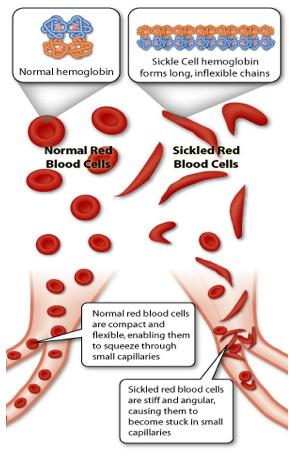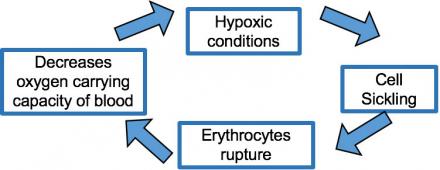Pathophysiology of Sickle Cell Disease
Jennifer L. Mathews, Ph.D.
Learning Objectives:
- Define intrinsic hemolytic anemia and how it relates to sickle cell disease.
- Describe the pathophysiology and genetics associated with sickle cell disease.
- Describe vaso-occlusive crisis, avascular necrosis, and acute chest syndrome.
Intrinsic Hemolytic Anemia
- Inherited
- Abnormal genes lead to abnormal erythrocytes
- Fragile or malformed, do not function correctly
- Destroyed more easily
- Types
- G6PD Deficiency
- Sickle Cell Anemia
- Thalassemias
- Aplastic Anemia
Sickle-Cell Disease
Image

- Mutation in one of the 146 amino acid molecules in a beta-globin chain leads to production of abnormal hemoglobin (hemoglobin S, HbS)
- Under hypoxic conditions, the beta chains link together
- Form stiff rods that are sharp and spike-like
- RBC becomes crescent-shaped
- RBCs rupture easily and dam up small vessels
- Can cause extreme pain and loss of circulation
https://ghr.nlm.nih.gov/condition/sickle-cell-disease#genes
A Vicious Cycle
Image

- Once the process starts, it progresses rapidly
- Patients can decompensate quickly, within a few hours:
- Dangerously low erythrocyte counts
- Will lead to death if not treated promptly
Vaso-occlusive Crisis
- Acute pain
- Can occur without warning
- Pain described as sharp, intense, stabbing, or throbbing
- Pain often occurs in the:
- Lower back
- Legs
- Arms
- Abdomen
- Chest
- Can be brought on by triggers
https://www.nhlbi.nih.gov/health-topics/sickle-cell-disease
Crisis Precipitation
The following may precipitate a vaso-occlusive crisis in a patient who has sickle-cell disease:
- High altitudes
- Rigorous exercise
- Hypothermia
Triggers for Vaso-occlusive Crisis
- Illness
- Changes in temperature
- Stress
- Dehydration
- High altitude
https://www.nhlbi.nih.gov/health-topics/sickle-cell-disease
Avascular Necrosis
- Caused by repeated disruptions in blood flow to the joint
- Usually found in adolescents and adults, not children
- Sickling in the bones of the hip, shoulder joints, knees, and ankles
- Decreased oxygen flow results in severe damage
- Symptoms:
- Pain and problems with walking and joint movement
https://www.nhlbi.nih.gov/health-topics/sickle-cell-disease
Acute Chest Syndrome
- Caused by occlusion of blood vessels in the lungs
- Lungs can be deprived of oxygen causing tissue damage
- Often starts after a painful crisis
- Symptoms:
- Pain
- Fever
- Shortness of breath
- Cough

